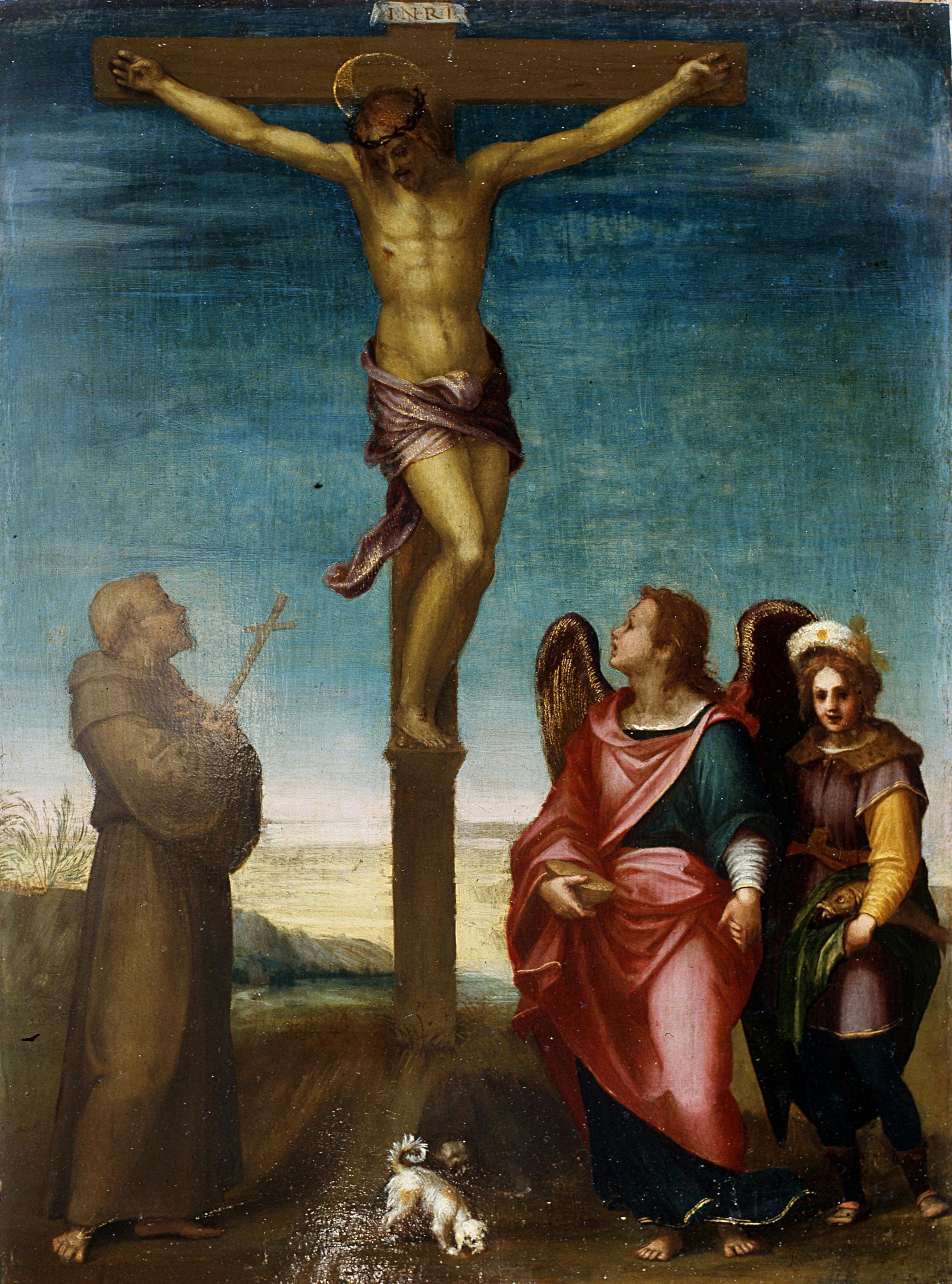Crucifix with St Francis, Archangel Raphael and Tobiolo
Andrea d'Agnolo, known as Andrea del Sarto (Florence 1486-1530)
At the foot of the cross from which hangs the dead body of Jesus are gathered in adoration St Francis, on the left, depicted while clutching a small cross to his breast, and the Archangel Raphael on the right. The young Tobiolo, on the other hand, looks towards the spectator, as if to introduce the moment of meditation and prayer on the mystery of death that is taking shape next to him. The fish hidden under his arm is the one that, according to the Bible, was caught by Tobiolo in the Tigris River with the help of an angel, to use its bile as a cure for his father's blindness. The little dog, which, according to tradition, accompanies the boy on his journey to collect a debt incurred by his parent, wanders heedlessly at the foot of the cross, sniffing the ground. In the background, a deep blue sky, streaked with clouds, gently fades into the rosy tones of a distant sunset to meet the bare landscape of Middle Eastern desert. In the soft chiaroscuro of the skin tones, Andrea kept Leonardo's teaching in mind, while the way in which he conceived the figures through correspondences of movements and colours is in continuity with his masters of late 15th century, from Ghirlandaio to Piero di Cosimo, as well as with Franciabigio, his contemporary and fellow artist. Thanks to its composure, this panel recalls the early frescoes with the stories of St. Philip Benizi preserved in the cloister of the Basilica of the Most Holy Annunciation in Florence, and is therefore dated to the end of the first decade of the century.
We know a great deal about the history of this painting, which was listed in the inventory of Andrea del Sarto's house drawn up after the death of his wife Lucrezia on 14 January 1570. According to the testamentary disposition of the painter, who died in 1530 with no male heirs, on the death of his wife Lucrezia, both the house of Via San Sebastiano in Florence (today Via Gino Capponi) and the property it contained, should have passed to the Ospedale degli Innocenti, an important Florentine charity institution to which Andrea was linked, which was supposed to sell the property and use part of the proceeds to provide a dowry for the daughters of his brother Domenico. In the meantime, however, the panel had already been donated to the Medici. The work was displayed in the Tribune throughout the 17th century and then removed to be transferred to other Medici residences. It has been displayed once again in the Tribune since 2012.
S. Meloni Trkulja, in S. Padovani e S. Meloni Trkulja, Il cenacolo di Andrea del Sarto a San Salvi, Firenze 1982, pp. 50-51, tav. 26; S. Padovani, in Andrea del Sarto 1486 - 1530; dipinti e disegni a Firenze, catalogo della mostra (Firenze, Palazzo Pitti, 8 novembre 1986-1 marzo 1987), a cura di M. Chiarini, Firenze 1986, scheda 2, pp. 89-90; G. Malanima, Andrea del Sarto a Castelnuovo d’Àvane, Firenze 2011, pp. 25, 36, 85, 98; L’eredità di Andrea del Sarto, “inventario delle robe”, a cura di G. Malanima, Firenze 2015, p. 31.
